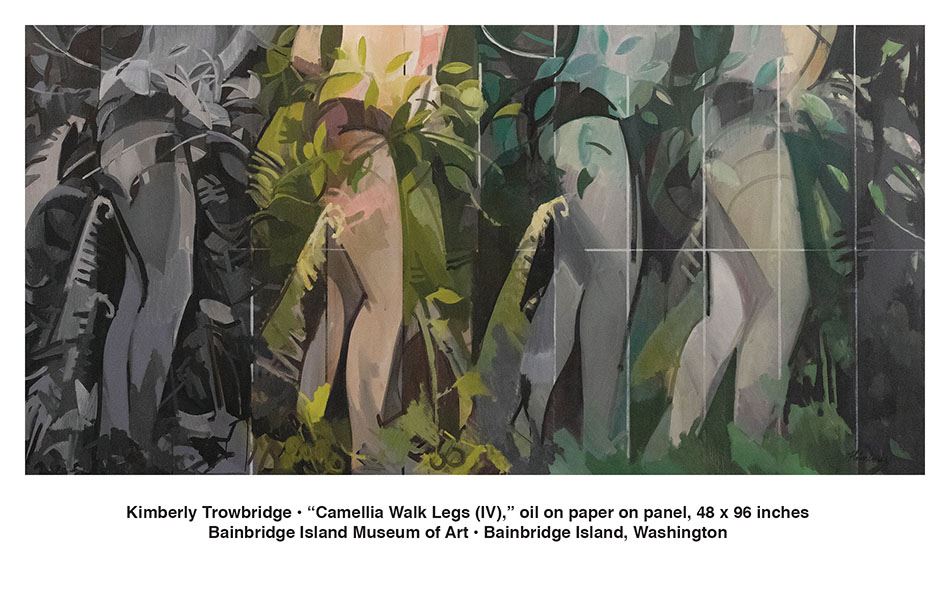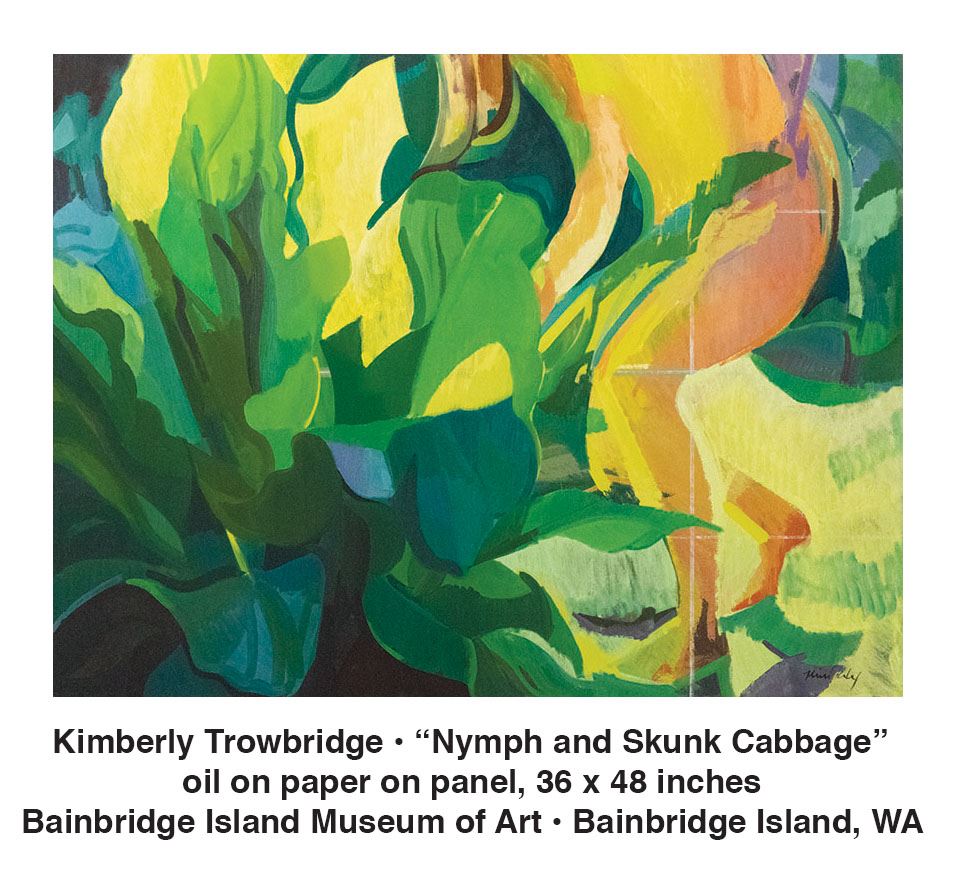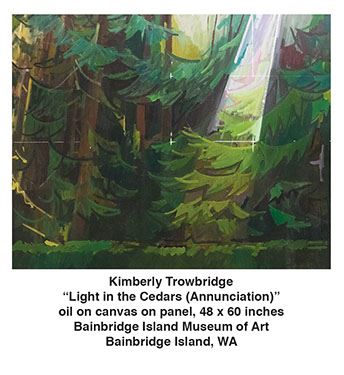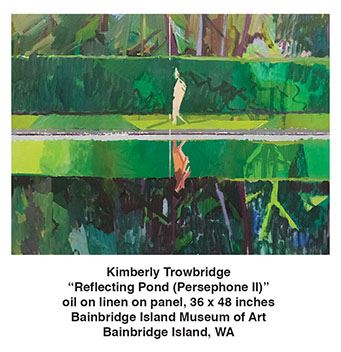
“When we enter the Garden
the boundaries of the self are blurred.
When we enter the Garden
we enter an erotics of perception.”
— Kimberly Trowbridge
 What does it mean to lose oneself in a landscape? Maybe it’s your shadow joining the others in the forest, or your fingers brushing the fronds of a fern, or even your reflection in the water. How do you experience time, space, light, or darkness in such a situation? Would you feel out of space and time, perhaps on the threshold from one moment or plane to the next? Kimberly Trowbridge’s time at Bloedel Reserve and the resulting paintings are a visual manifestation of her experiences and observations about light and dark, time and moments, and space and observations. The paintings are an exploration of perception and self; each captured from either a specific moment, series of moments, or reality.
What does it mean to lose oneself in a landscape? Maybe it’s your shadow joining the others in the forest, or your fingers brushing the fronds of a fern, or even your reflection in the water. How do you experience time, space, light, or darkness in such a situation? Would you feel out of space and time, perhaps on the threshold from one moment or plane to the next? Kimberly Trowbridge’s time at Bloedel Reserve and the resulting paintings are a visual manifestation of her experiences and observations about light and dark, time and moments, and space and observations. The paintings are an exploration of perception and self; each captured from either a specific moment, series of moments, or reality.
 From 2018 to 2020, Kimberly Trowbridge was a Creative Fellow at the Bloedel Reserve, a public garden and preserve located on Bainbridge Island. The Bloedel Reserve residency program seeks to provide artists with the opportunity to connect with the environment and nurture creative thinking through experiences with nature. Trowbridge’s paintings focus on four areas of the reserve: Camellia Trail, Meadow Trail, Moss Garden, and the Reflection Pond. Each area provides the artist with an opportunity to develop a new way of seeing the world and method for translating that into paint on canvas.
From 2018 to 2020, Kimberly Trowbridge was a Creative Fellow at the Bloedel Reserve, a public garden and preserve located on Bainbridge Island. The Bloedel Reserve residency program seeks to provide artists with the opportunity to connect with the environment and nurture creative thinking through experiences with nature. Trowbridge’s paintings focus on four areas of the reserve: Camellia Trail, Meadow Trail, Moss Garden, and the Reflection Pond. Each area provides the artist with an opportunity to develop a new way of seeing the world and method for translating that into paint on canvas.
Immediately upon entering the exhibition, the viewer is connected to Trowbridge through physical objects. Her easel, table, paints, and brushes are all on display for guests. Even her apron is draped over a stool as if to signify she just left the scene. From this vantage point the sightlines from the entrance of the gallery place a strong emphasis on tone, time, and light. Trowbridge writes that how she perceived light and shapes in the twilight hours deeply impacted her work. The three large paintings to the left of the entrance are an example of that heightened perception. First, “Light in the Forest (Annunciation)” illustrates the changing light beaming through the branches onto the forest floor below. Next, “Camellia Walk (IV)” portrays the tones that Trowbridge writes about in her wall text. But is also begs the question: is this one moment in time or one figure throughout time? Lastly, “Theater of Destruction” completes the informal triptych. Is the light coming or leaving the forest? It is hard to tell, but the leaves, meandering branches, and fallen tree remain either stuck in time or timeless.
The paintings mentioned previously are all observations from the Camellia and Meadow Trails, but Trowbridge also places emphasis on both the Reflection Pond and Moss Garden. In fact, the first painting in the large gallery focuses on the Reflection Pond. “Reflection Pond Persephone I,” is almost divided evenly between physical objects and their reflection in the water below. Gestural strokes of blue and green paint activate the canvas. The painting is laid out in a grid, but the paint often spills from one cell to another as if to show the viewer that the planes are overlapping and not as structured as once thought. The primary character in Trowbridge’s paintings of the pond is Persephone. In Greek mythology, Persephone was abducted by Hades and forced to spend part of the year (the winter) in the Underworld. However, as a goddess of nature she could leave for most of the year and is often associated with the spring season. It makes sense that Trowbridge uses this character to demonstrate this place as one of rebirth, transformation, and passage.
 It would be easy to continue writing about Trowbridge’s use of composition, narrative, and the conceptual depth of this new body of work. However, it would be an error not to comment on the use of color in the paintings, especially the vibrant earth tones. When asked about what they appreciated most about the exhibition, the gallery attendant commented, “The greens.” Spend time admiring and getting lost in the colors of “Nymph and Skunk Cabbage,” for example, from the Moss Garden. Each curve of the leaf generates a new color, either highlighted by the sun or hidden in shadow.
It would be easy to continue writing about Trowbridge’s use of composition, narrative, and the conceptual depth of this new body of work. However, it would be an error not to comment on the use of color in the paintings, especially the vibrant earth tones. When asked about what they appreciated most about the exhibition, the gallery attendant commented, “The greens.” Spend time admiring and getting lost in the colors of “Nymph and Skunk Cabbage,” for example, from the Moss Garden. Each curve of the leaf generates a new color, either highlighted by the sun or hidden in shadow.
“In the Garden” has been extended through June 27, and there are several other exhibitions on display at the Bainbridge Island Museum of Art as well. Enjoy Kimberly Trowbridge’s exploration of the consciousness through her direct observations of nature. And maybe, the viewer will notice something new on their next visit environmental exploration.
Chloé Dye Sherpe
Chloé Dye Sherpe is a curator and art professional based in Washington State.
“Kimberly Trowbridge: In the Garden” is on view through June 27, at the Bainbridge Island Museum of Art, located at 550 Winslow Way East on Bainbridge Island, Washington and open daily from 10 A.M. to 5 P.M. Visit www.biartmuseum.org for more information.